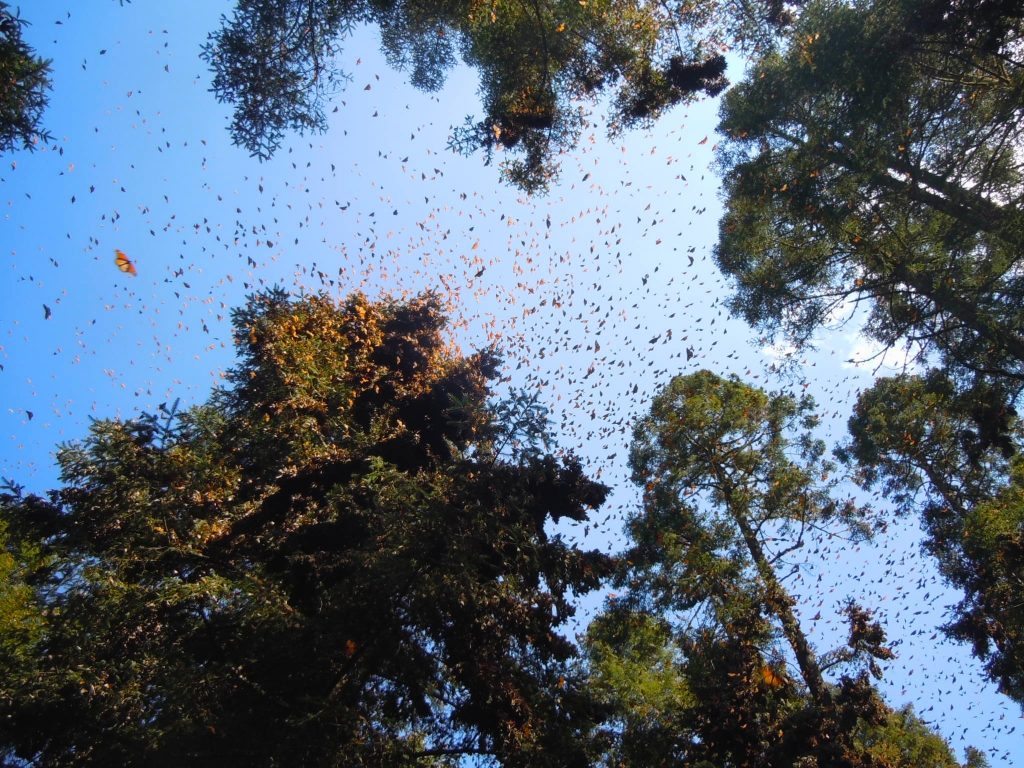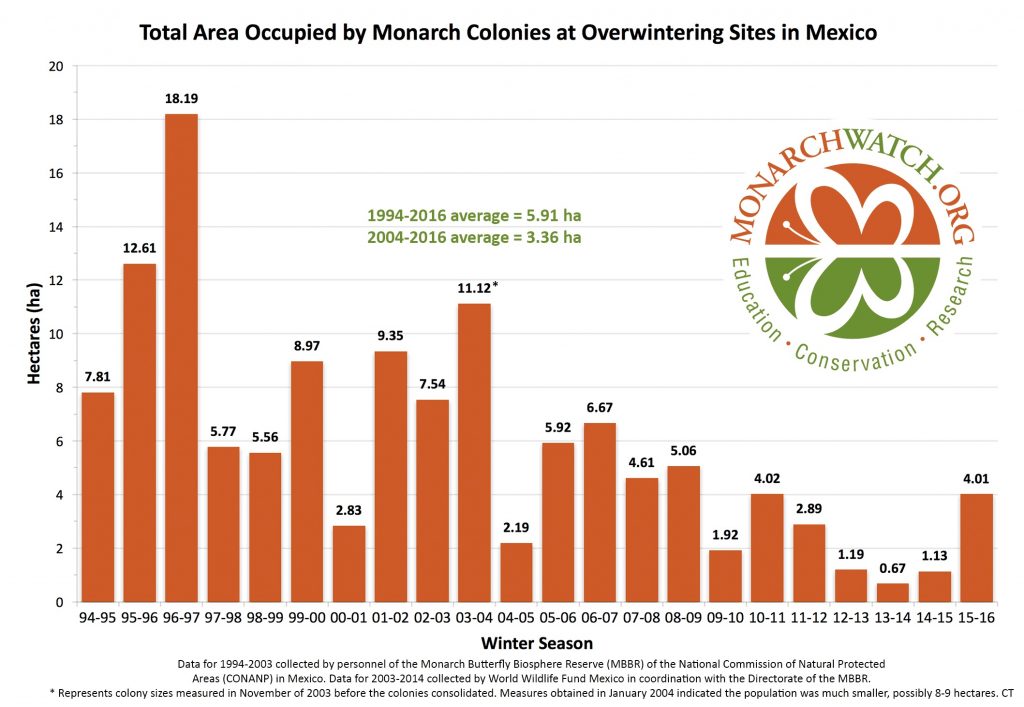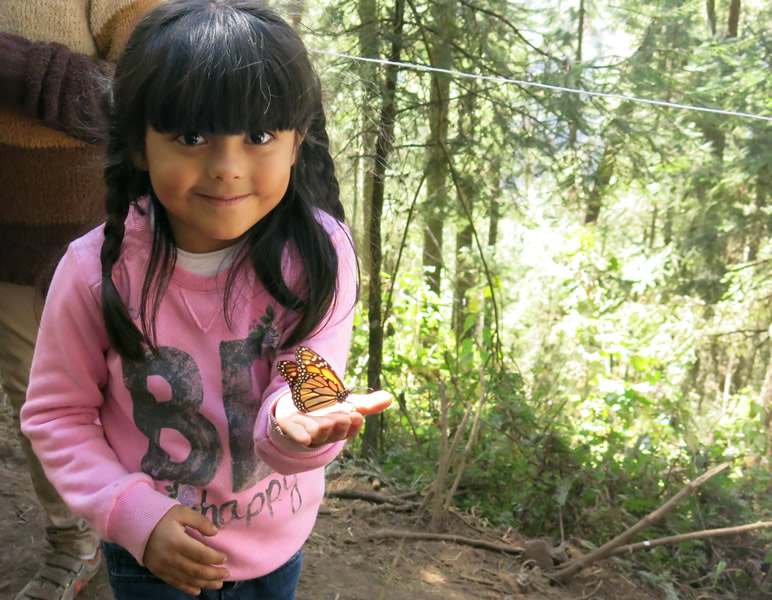The 2015-2016 Monarch butterfly population census is in and the news is good: the iconic migrating insect that has become a symbol for climate change and pollinator advocacy in three countries is on the rebound with a three-fold increase in its roosting population in the past year.

The Monarch population is on the rebound with a threefold increase over last year. Here they are in Michoacán in March of 2012. Photo by Monika Maeckle
Last year the population occupied 1.13 hectares (2.8 acres) of the Oyamel forest in the mountains of Michoacán that serve as the ancestral roosting site of the storied orange and black creatures. This year: 4.01 hectares (9.9 acres) are occupied–more than triple last year’s figure, according to the Mexican government and the World Wildlife Fund. Scientists calculate the population numbers by measuring the amount of forest occupied by the Monarchs.

According to Journey North, a citizen science organization that tracks the Monarchs’ and other migrations, this year’s population numbers 200 million monarchs compared to a long-term average of 300 million and a peak of 1 billion. The organization attributed the increase to ” favorable breeding conditions in summer 2015.”
The butterflies, which migrate each fall to the Mexican mountains after a multi-generation trek through the heartland of the United State’s to Mexico, have been in a perilous decline in recent years. The 2013-2014 season in particular was frightening: the entire Monarch population occupied only .67 hectares (1.65 acres) and could have fit into a Walmart store with 30,000 square feet to spare.
The insects made a slight comeback last year, as government officials in all three countries committed to work together to save the unique natural phenomenon. Research and funding have been pouring into the cause, thanks, in part, to President Obama’s National Pollinator Strategy issued in May of 2015.

As temperatures rise and the air dries, monarchs move out of their clusters in Michoacán during the day to the delight of sanctuary visitors. Photo via Journey North
Butterfly aficionados far and wide were delighted with the news. “Great progress!! Everyone still needs to do their part to help! We can’t lose these magnificent butterflies!!” wrote Eileen Cotte on Journey North’s Facebook page.
“It certainly is reason for hope following year after year of depressing declines,” wrote Richard Knowles on the DPLEX list, an old school listserv of about 800 butterfly aficionados run by citizen science organization Monarch Watch out of the University of Kansas at Lawrence. “It almost feels like everyone can give themselves a brief pat on the back before getting back to work.”
Even Monsanto Corporation, often blamed for the butterflies decline because of the indiscriminate pesticide use that results from their genetically modified corn and soybean seed, celebrated the news: “Good news! Monarch population numbers were up in 2015. With help, they’ll keep increasing.”
We hope so. Let’s keep planting milkweed and nectar plants for all pollinators.
Related posts:
- Mighty Monarch butterflies brave south winds, Hurrican Patricia to arrive in Mexico
- Q & A Elizabeth Howard of Journey North talks tech, citizen science, butterfly releases
- Q & A: Catalina Trail, founder of the Monarch butterfly roosting sites
- 2015 a Banner Year? Monarch butterfly migration heading our way
- Q & A: Dr. Lincoln Brower on Endangered Species, Ethics, Milkweed and Monarchs
- How to tag a Monarch butterfly in Six Easy Steps
- Endangered Species Act Wrong Tool for the Job of Monarch Butterfly Conservation?
- Monarch Butterfly Inches Toward “Threatened” Status Under Endangered Species Act
- How to Get Native Milkweed Seeds to Germinate
- Native American Seed and the Challenges of Persnickety Texas Native Milkweeds
- How to Raise Monarch Butterflies at Home, Part One
Like what you’re reading? Follow butterfly and native plant news at the Texas Butterfly Ranch. Sign up for email delivery, like us on Facebook, or follow us on Twitter, @monik

There is still hope!! Fabulous photos from our friend Joe Galkowski taken at their wintering spot in Pacific Grove, CA. More photos at SaveOurMonarchs.org
It’s not logistically feasible for humans to create new monarch habitat in a way that could increase the size of the wild monarch summer breeding and fall migratory populations. Why? Because 1,000,000,000’s of milkweed plants already grow in the wild in the eastern
and central USA, hence the biological value of whatever 1,000’s, 10,000’s or even 100,000’s additional milkweeds are planted will be vanishingly small…
just like any person who has $1,000,000,000 in the bank would consider a gift of $100,000 as pocket change that will not increase his/her net worth.
I have raised/birthed over 150 Monarchs in the past year. I have 10 caterpillars in my enclosure right now. Seems they populate all year here in Ft. Lauderdale.
They are so awesome to watch!
Glad I am helping to keep them off the endangered species list!
Many thanks to all the great people & govt support for the Monarch recovery ! Lets keep this great support going ! We love butterflys 🙂
I love monarch butterflies
Reading this article made me happy to hear the population of Monarchs that live, breed and migrate in the Mid West and Eastern U.S. that migrate into Mexico seem to be climbing in numbers.
However, I can remember as a boy of 9 visiting Pacific Grove along the California coast and seeing Eucalyptus and Monterey Pine trees covered with over wintering Monarchs. These come from the western regions and migrate along the Pacific Flyway. This was about 45 years ago.
Going back to the same area at the same time of year in 2015 one would be hard pressed to believe you were actually visiting a Monarch Butterfly winter preserve. That’s unfortunately how few Butterflies were actually there.
I would see Monarch butterflies commonly passing through my part of California years ago…and in the northern and central part of the State it was easy to find caterpillars on our Purple Milkweed. Today it might take me an entire day of searching one area of established Milkweed to find a single Monarch caterpillar.
When you’re out in nature studying it every season you can see the difference in certain populations of butterflies from year to year. Most species seem to be holding their own and in some cases doing quite well. The Monarch…at least in my area doesn’t seem to be one of them.